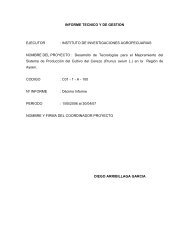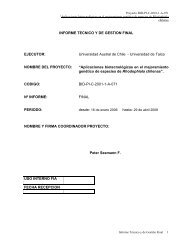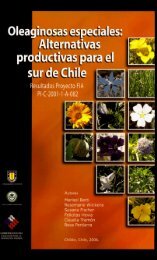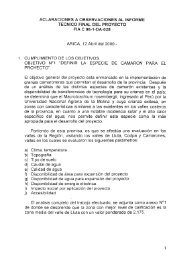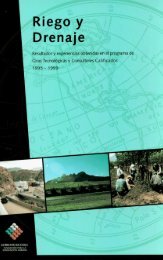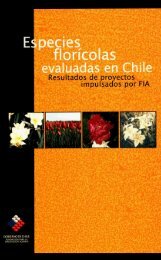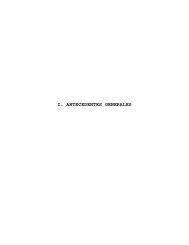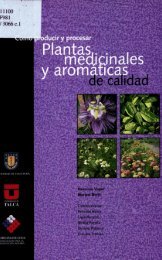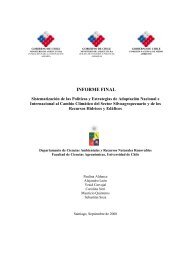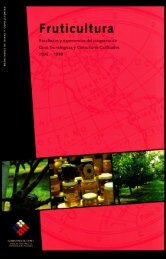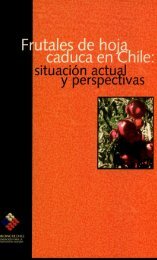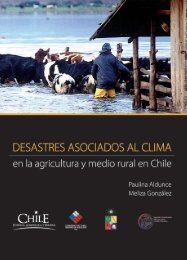Los residuos agrÃcolas y su uso en la alimentación de rumiantes
Los residuos agrÃcolas y su uso en la alimentación de rumiantes
Los residuos agrÃcolas y su uso en la alimentación de rumiantes
Create successful ePaper yourself
Turn your PDF publications into a flip-book with our unique Google optimized e-Paper software.
LOS RESIDUOS AGRICOLAS Y SU US0 EN LA ALIMENTAC16N DE RUMIANTES / Cap6rUlO 1<br />
ya que se cosecha a mano. Este recurso pue<strong>de</strong> ser mejor utilizado por 10s animales si se<br />
ofrece picado. Su valor nutritivo es inferior al <strong>de</strong> 10s porotos, pues pres<strong>en</strong>ta un valor <strong>de</strong><br />
proteina <strong>de</strong> 7 a 8% y una digestibilidad <strong>de</strong> 60% (Cuadro 1.7) (Mantero<strong>la</strong> et a/., 1993).<br />
1.2.1 A Paja <strong>de</strong> chlcharos (Lathyrus sativus Lo)<br />
El area <strong>de</strong> cultivos se exti<strong>en</strong><strong>de</strong> <strong>en</strong>tre <strong>la</strong> VI y Vlll Regibn, tanto <strong>en</strong> 10s sectores <strong>de</strong><br />
precordillera como <strong>en</strong> 10s secanos interior y costero. Es un cultivo muy asociado a <strong>la</strong><br />
pequeiia propiedad y se utiliza principalm<strong>en</strong>te <strong>en</strong> animales <strong>de</strong> tiro y vacas <strong>de</strong> lecheria<br />
casera. La paja <strong>de</strong> este cultivo es <strong>su</strong>perior <strong>en</strong> valor nutritivo a <strong>la</strong> paja <strong>de</strong> garbanzos y <strong>de</strong><br />
porotos, y muy simi<strong>la</strong>r a <strong>la</strong> paja <strong>de</strong> l<strong>en</strong>teja (Cuadro 1.7), Asimismo <strong>su</strong> aceptabilidad por<br />
10s animales es alta, ya que <strong>su</strong>s estructuras <strong>de</strong> tallos principales y secundarios son<br />
<strong>su</strong>aves y re<strong>la</strong>tivam<strong>en</strong>te <strong>de</strong>lgadas. A<strong>de</strong>mas <strong>la</strong>s hojas nose <strong>de</strong>spr<strong>en</strong>d<strong>en</strong> como <strong>en</strong> el cas0<br />
<strong>de</strong>l garbanzo.<br />
1.2.1.5 Paja <strong>de</strong> arvejas (Pi<strong>su</strong>m sativum L.)<br />
El area <strong>de</strong> cultivo est6 conc<strong>en</strong>trada <strong>en</strong> <strong>la</strong> V y VI Regibn, por <strong>en</strong>contrarse all1 <strong>la</strong>s principales<br />
agroindustrias compradoras <strong>de</strong>l grano. La paja <strong>de</strong> este cultivo ti<strong>en</strong>e un valor nutritivo<br />
simi<strong>la</strong>r a <strong>la</strong> <strong>de</strong> porotos. El cont<strong>en</strong>ido proteico fluctha <strong>en</strong>tre 7 y 11% y <strong>la</strong> digestibilidad<br />
<strong>en</strong>tre 50 y 60% (Cuadro 1.7). Su estructura es mas <strong>su</strong>ave que <strong>la</strong> <strong>de</strong>l poroto, por pres<strong>en</strong>tar<br />
tallos mas finos y <strong>la</strong>rgos y gran cantidad <strong>de</strong> guias <strong>la</strong>terales. Como normalm<strong>en</strong>te se cosecha<br />
el grano <strong>en</strong> ver<strong>de</strong>, <strong>la</strong> paja es muy apetecida por 10s animales.<br />
1.2.2 US0 EN ALIMENTACIdN DE RUMIANTES<br />
Las pajas <strong>de</strong> legumbres, por <strong>su</strong> mayor valor nutritivo y aceptabilidad por parte <strong>de</strong> 10s<br />
animales, se pued<strong>en</strong> incluir <strong>en</strong> niveles mAs altos que <strong>la</strong>s pajas <strong>de</strong> cereales. Como ljnico<br />
recurso forrajero, cubre 10s requerimi<strong>en</strong>tos <strong>de</strong> mant<strong>en</strong>cih <strong>de</strong> vacas durante 10s primeros<br />
2/3 <strong>de</strong>l periodo <strong>de</strong> gestaci6n. En vacas <strong>de</strong> carne, durante <strong>la</strong> <strong>la</strong>ctancia pue<strong>de</strong> servir <strong>de</strong><br />
complem<strong>en</strong>to al <strong>en</strong>si<strong>la</strong>je y mejorar el aporte proteico, especialm<strong>en</strong>te <strong>en</strong> <strong>en</strong>si<strong>la</strong>jes <strong>de</strong> maiz.<br />
En novillos, pue<strong>de</strong> incluirse hasta un 40% <strong>en</strong> <strong>la</strong> racibn, siempre que losotros compon<strong>en</strong>-<br />
tes Sean <strong>de</strong> bu<strong>en</strong>a calidad (Cuadro 1.8). En vacas <strong>de</strong> lecheria, durante el periodo final <strong>de</strong><br />
gestacibn, pue<strong>de</strong> incluirse hasta <strong>en</strong> un 30%; y durante el periodo <strong>de</strong> <strong>la</strong>ctancia, <strong>en</strong> vacas<br />
sobre 25 litros, no convi<strong>en</strong>e incluir mas <strong>de</strong> 15-20%, por <strong>la</strong>s limitaciones <strong>en</strong> el con<strong>su</strong>mo.<br />
39




